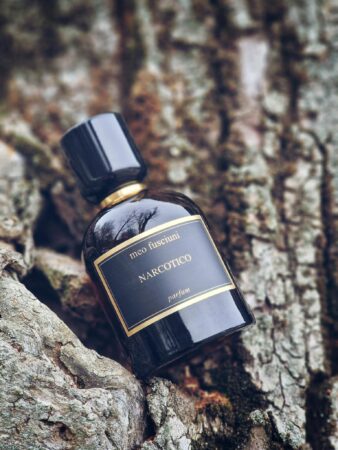
Meo Fusciuni Narcotico photo by Nicoleta
Fragrant alchemy woven into perfume molecules with scientific sense, poetic sensibility, and infinite care for detail: a true Italian soul, distilled in apothecary bottles. Meo Fusciuni started out thirteen years ago, as a project of olfactory research – in a fusion of perfumery, herbology, and botany. There are deep roots that connect the art to the creator’s beloved land of Sicily, starting with the name of the brand: proudly and profoundly Italian: Meo, the diminutive of Bartolomeo, Giuseppe Imprezzabile’s father and and “Fusciuni” which means “to flow” and also his grandfather’s nickname.
Meo prefers to be called “aromatorio”, not a nose or perfumer, with a term coming from old apothecaries of the past, describing a person who had herbal knowledge and the right way to use spices and medicinal plants. He was born in the spring of ’77, in Mazara del Vallo – on the western coast of Sicily, surrounded by history, and colorful tales of his extended family of fishermen and navigators (as Mazara is home to one of the largest and oldest fishing fleets), with Tunis just a (long) stone’s throw away, across the sea. After spending his youngest years in a city that is a fascinating mix of culture, history, art, and ethnicity, Meo moved north and dedicated his youth to science – biochemistry, herbal techniques, ethnobotany, aromatherapy, and not in the least – anthropology.
If I come to think of it, most of the creators I hold closest to my heart have the same qualities about them. And maybe the saying “All roads lead to Rome” applies here as well, for they are all Italian. For it takes a “Renaissance man” to effortlessly blend into reality such abstract, complex, and intellectually stimulating concepts while giving them the most gut-wrenchingly emotional, intense, and poetic olfactive flesh. And I’m thinking of Francesca Bianchi, Angela Ciampagna, Filippo Sorcinelli, Antonio Alessandria, and Angelo Pregoni – to mention but a few I’ve been fortunate enough to discover these last years.

Giuseppe Imprezzabile, photo via the brand
Narcotico opens up the Mystic Trilogy, a series of three perfumes inspired by sacred places of the human soul: “Perfumes and odors, mystical states intertwined, in the most intimate depths of our soul, the perfume takes shape, tells our story, who we are. The encounter with our deepest memories can be upsetting, this is what I tried to create with Narcotico, a personal journey, deep, in the most hidden olfactory memories of my soul. Narcotico tells, through a trip to Palermo, a city of a thousand contrasts, among its alleys and churches, the spiritual journey of the soul, of my personal relationship with the Sacred.” – in a note from Meo
I’ve made it no secret that my favorite outlet for imagination is gaming, so for my role-playing soul, Meo’s creations to read to me not as perfumes but more as magical “quest items” that open up a new universe, ones I wouldn’t have experienced otherwise. Many years ago, during my research of the fairy mythology of Europe, while looking for real references for the magical creatures that were to inhabit a fantasy game, I came across the obscure legend of the Monaciello – “It is not the gnome dancing on the soft grass of the meadows, nor the elf that sings on the shores of the river, it is the imp of the old houses of Naples. It is ‘o monaciello.”*
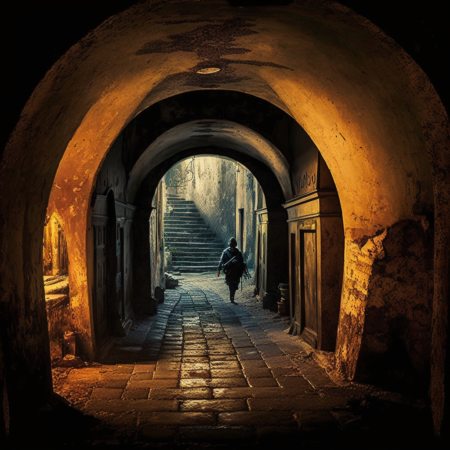
AI-generated image of the tunnels beneath Naples by Nicoleta©
Just take a moment to think that all along the centuries, cities and urban landscapes visibly change from one decade to the next, but it’s not the case for the underground passageways that are unchanged, in some cases, for two thousand years. For example, to take possession of Naples many conquerors – starting as early as the year 500, with Belisarius – had the idea of using the aqueducts that spun like stone labyrinths beneath the cities. And where there are shadows, legends bloom in darkness.
The Monaciello is one of the oldest urban legends, first appearing in Naples and then growing in popularity outside the city, where the little one was dwelling in the imposing remains of different abbeys and monasteries that are scattered all over Southern Italy. When he appeared to it was always close to midnight, and it was said that he only showed himself to those who were in dire need of help, those who have done all that a mortal could do, to alleviate the misery fallen upon them. Only then, the little creature would appear and mutely lead them to where a secret treasure was concealed, without no words, no conditions, no demands, and no service in return. Some variations on the legend speak of the coins and gold turning back to leaves or stones if the person receiving the gift would prove unworthy and spoke of the encounter.
The genesis of the Monaciello story is linked to the water cisterns beneath Naples and their workers who had easy access to every house through the intricate and narrow underground system, named “cunicoli”. The workers, named “pozzari” were small in size, agile, good climbers, and had access to the many passageways to enter people’s homes at night, play tricks, and collect unpaid bills.
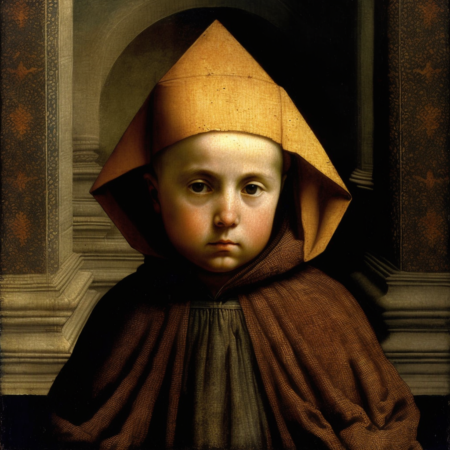
AI-generated image – the imagined painting of the Monaciello, inspired by the style of Antonello da Messina
In another version of the story, somewhere in the mid-1400, Caterinella Frezza, the daughter of a wealthy merchant fell in love with Stephen Mariconda – who was but a modest laborer. Their families opposed the relationship, and one night Stephen was murdered in their secret meeting place. Caterinella was sent to the convent, where she soon died after giving birth to a very strange child. The nuns adopted him, the years passed but the kid never grew bigger than the size of a six-year-old. He had a disproportionately large head, on which he wore a black hat and hid his small body in oversized monk’s robes. People began to fear and blame the little monk for all of their misfortunes. Except when he wore a red cap, which was seen as good luck. The legend also penetrated colloquial language, a popular saying goes Forse avrà il munaciello in casa (perhaps he has the Monaciello at home) if a person has good fortune. It’s worth noting that this legend also appears, slightly modified in Germany and Ireland – Rubezahl and O’Donoghue fill in similar roles, another connecting element being the proximity to underground waters and canals.**
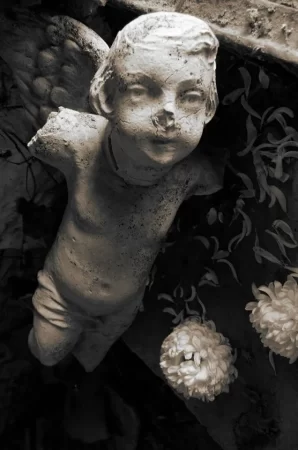
Meo Fusciuni Narcotico artwork by Nicoleta
The connection between the beautiful legend and Narcotico began for me at the entrance – with the illustration of the broken stone angel depicted on the perfume box. Then, on the skin, my imagined story began to unfold.
If the legend of the Monaciello had an olfactive layer, playing with odors the same music punctuates emotions in a movie, Meo Fuscuini Narcotico would be it. From the stone-walled monasteries to the water-filled canals unseen by light for thousands of years, this is a journey that will make you travel inwards, for as far as you allow yourself to go. The light flickers, like in a silent movie, from the rain-soaked walls of the monastery, floating inside the incense-filled corridors, echoing the little steps all the way to the infirmary. It sometimes stops and zooms in slowly, as we watch the nun’s wrinkled hands firmly pressing the cold handkerchief on a small forehead, drawing aside the unruly hair that would touch the fabric and borrow the bitter menthol aroma of the crushed plants. Then it fast forwards to ancient canals, outside of time, then flies up to the cold blue skies, Icarus of a white flash of light, fast and straight as an arrow, all the way to the warm orange light of the sunset, seen from a minaret in the mirrored world across the sea.
Narcotico vibrates on a low frequency, it can feel dark, brooding, menacingly medicinal, and as metallic as the cold coins of a forgotten treasure. But after a while, the red cap of the Monaciello appears and peels the thick bark until the black sign of the eagle appears in the nervures of the oud tree. All the herbs from the belly of the world will be dug out, roots still laden with wet earth, for you to dive in all the richness one can dream of.
In the end, I smile and think of how the circle closes and the Romanian legend of “iarba fiarelor” or the beast’s grass – one mysterious plant from local lore that was said to open any locks, chests, and doors – thus giving its possessor the chance of infinite fortune and limitless freedom.
Fragrance notes: Top: incense, thyme; middle: tonka bean, benzoin; base: patchouli, vanilla, musk, oud
Disclosure: The bottle was kindly offered by Meo Fusciuni. As always, my opinions are my own.
Nicoleta Tomsa, Senior Editor
Editor’s note: I’ve been in awe of Meo’s otherworldly ways also regarding his dark ambient music project Nenia Meo Fuscuini Narcotico has been conceived and created listening to the albums La Casa del Dolore and Memorie Statiche, hear them here.
* quote from author Matilde Serao, book “Neapolitan Legends”
**Information taken from the book “The Fairy Family: A Series of Ballads & Metrical Tales”, Archibald Maclaren, London (1857)
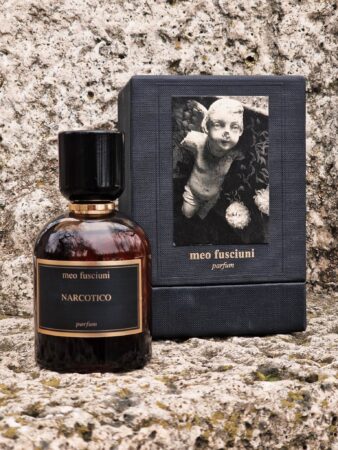
Meo Fusciuni Narcotico bottle & box, photo by the brand
Thanks to the generosity of Meo Fusciuni we have a 100 ml of Narcotico for one registered reader anywhere the brand ships to…check out the countries here You must register or your entry will not count. To be eligible, please leave a comment saying what sparks your interest based on Nicoleta’s review of Meo Fusciuni Narcotico and where you live. Draw closes 2/10/22
Meo Fusciuni Narcotico was released in 2015
Also please read our essays: Meo Fusciuni Encore du Temps, Varanasi, Spirito, Little Song Notturno
Meo Fusciuni fragrances are sold throughout the globe and here in the USA, please check the entire line out at Fragrance Vault
Follow us on Instagram @cafleurebonofficial @nicoleta.tomsa @meofusciuni_parfums
This is our Privacy and Draw Rules Policy
We announce the winners only on our site and on our Facebook page, so like ÇaFleureBon and use our blog feed… or your dream prize will be just spilled perfume
Like our Facebook page: Çafleurebon and use our blog feed for new updates and articles
